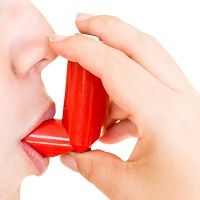Article
Tiotropium Inhaler Add-On Improves Lung Function in Young Asthmatic Patients
Author(s):
Even with the combination of inhaled corticosteroids (ICS) and long-acting beta agonists (LABAs), about 46% of young patients still suffer from poorly controlled asthma. A new analysis found that an add-on inhaler may be just what patients need to reach improved lung function.

Even with the combination of inhaled corticosteroids (ICS) and long-acting beta agonists (LABAs), about 46% of young patients still suffer from poorly controlled asthma. A new analysis found that an add-on inhaler may be just what patients need to reach improved lung function.
Tiotropium, marketed under the Spiriva delivered through the Respimat inhaler, has proven to be both safe and effective in adolescent patients. Mark Vandewalker, MD, from the Clinic Research of the Ozarks in Columbia, Missouri, displayed the findings during a poster session at the 2015 American College of Allergy, Asthma, and Immunology Annual Scientific Meeting (ACAAI 2015) in San Antonio, Texas.
A total of 397 patients from ages 12 to 17 were enrolled in the study — about 64% male and an average Asthma Control Questionnaire score of around 1.5. They were randomly assigned to either receive tiotropium 5 µg (two inhalations of 2.5 µg), tiotropium 2.5 µg (two inhalations of 1.25 µg), or two inhalations of a placebo. The treatment was an add-on to ICS maintenance therapy, with or without a leukotriene receptor antagonist (LTRA). The ICS dose for ages 12 to 14 could be 200 to 800 µg budesonide or equivalent, and ages 15 to 17 could be 400 to 800 µg budesonide or equivalent.
“The full dose of study treatment is administered in two inhalations and is monitored by a dose indicator on the rear of the device,” the authors explained the Respimat inhaler. The primary endpoint was to determine efficacy based on peak forced expiratory volume (FEV) within three hours over the dose by week 24. They also aimed to measure FEV 10 minutes before medication administration and compare it to baseline. Notably, 21 patients (5.3%) dropped out of the trial.
“In the overall patient population, responses were significantly higher in the tiotropium 5 µg versus placebo,” the authors discovered. “Tiotropium add-on therapy improved peak FEV responses at Week 24 compared with placebo.”
Also compared to the placebo, the tiotropium groups showed additional improvements: 2.5 µg dose — IgE Ë‚ 430 µg/L and both 2.5 µg and 5 µg – IgE ˃ 430 µg/L. Serious adverse effects were minimal but consistent throughout the three groups.
The team concluded that tiotropium was an independent factor which led to improved lung function. This indicates that young patients with moderate symptomatic asthma could benefit from the once-daily tiotropium Respimat.



